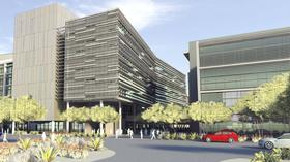When you think of Arizona you may picture scenic vistas, some of the world’s greatest golf courses, the nation’s largest public university (ASU) and lots of sun.
On a statewide basis, Arizona is heating up. In 2011, the Arizona Legislature passed the Arizona Competitiveness Package to further stimulate the economy and foster more research, innovation and commercialization in the state. Arizona’s new Competitiveness Package (HB2001) provides the most sweeping economic development legislation seen in decades. The many new features and incentives allow businesses to:
- Earn income tax credits up to $9,000 for each new job under the Quality Jobs Program
- Obtain renewable energy income tax credits and property tax reductions
- Tap into Arizona’s $25-million deal-closing fund
- Receive up to $1.5 million in reimbursable grants to train employees
- Leverage up to a 34-percent research and development tax credit
- Take advantage of Arizona’s 100-percent electable sales factor for multi-state corporations
- Benefit from a 30-percent reduction in Arizona’s corporate income tax rate
- Capitalize on Arizona’s reduced commercial property assessment ratio — 18 percent by 2017
- Improve their bottom lines with a 15-percent increase in personal property exemptions.
Greater Phoenix

Image courtesy of the City of Phoenix
When it comes to the largest city in the 48th state, things are on the rise in more ways than one with the expansion of both the University of Arizona Medical School and the Arizona Cancer Center into Phoenix. The blooming downtown biomedical complex is anchored around the medical school, the Translational Genomics Research Institute (TGEN) led by Dr. Jeffrey Trent, the International Genomics Consortium led by Dr. Robert J. Penny, and, in nearby Tempe, The Biodesign Institute at Arizona State University.
Encompassing 350,000 sq. ft. (32,515 sq. m.) of award-winning, state-of-the-art, LEED-certified buildings, the Biodesign Institute represents the state’s largest research infrastructure investment in bioscience-related research. ASU is the first university in the U.S. to create an interdisciplinary research Institute entirely devoted to bio-inspired innovation principles, representing a vast expansion of ASU’s state-of-the-art research capacity.
The greater Phoenix area includes leading healthcare and research institutions like the Mayo Clinic, the Arizona Heart Hospital, Banner/MD Anderson, Cancer Centers of America and Catholic Health Care West/Barrow Neurological, while global leaders such as Medtronic, Medesis, Celgene and Bard Peripheral Vascular take the lead in furthering research and commercialization.
Dr. Patrick Soon-Shiong, a billionaire physician and entrepreneur, announced this spring that Phoenix would be home to The Institute for Advanced Health. The institute is part of Soon-Shiong’s vision of streamlining the delivery of health care in America by creating a centralized database that houses biomedical information so hospitals and healthcare providers can access the most up-to-date information on patients and how to treat specific conditions, and connecting medical professionals from the bench to the bedside worldwide.
Southern Arizona
Agriculture. Engineering. Medicine. Pharmacy. Science. These are the five original disciplines the University of Arizona’s BIO5 Institute has harnessed to forge solutions to the complex biology-based challenges affecting humanity.
Moving new ideas from BIO5 labs to the marketplace is another facet of BIO5’s agenda. BIO5 facilitates connections between researchers and industry that translate university research into products that meet the needs of humanity today. Creating the next generation of scientists is at the top of BIO5’s to-do list as well, because a pipeline of well-trained, creative scientists ensures continuing creativity and collaboration, and thus, innovation.
University of Arizona undergraduate and graduate students can take advantage of research training, industry internships and career development programs. Companies whose founders once called the University of Arizona home include Selectide (acquired in 1995 by Marion Merrell Dow and now sanofi-aventis); Ventana Medical, a Roche Company; Syncardia (manufacturer of the artificial heart) and Cord Blood Research, a leader in the emerging field of stem cells.
Northern Arizona
For more than 30 years, W. L. Gore & Associates has provided surgeons and patients with a wide variety of healing solutions. Thousands of Gore employees call Flagstaff home. From that base they create medical products that offer new solutions to medical challenges, working with the body’s own tissues and organs to allow less invasive procedures and restore normal functioning. Flagstaff is also home to Northern Arizona University. The smallest of Arizona’s three Regents Universities, NAU is a valued partner of Science Foundation Arizona (SFAz), Northern Arizona Center for Emerging Technologies (NACET), and the Colorado Plateau Cooperative Ecosystem Studies Unit (CP-CESU). NAU’s core facilities and expert researchers provide resources to emerging bioscience companies including Pathogene, Flagship Biosciences, and TGen North.
Capital Needed
So that’s what’s hot, but what does it take to turn the heat up even more? Ask anyone involved in the bioscience fields anywhere and the answer is the same: capital. Biomedical, ag-bio and biofuels projects all need capital to heat things up and move forward faster toward commercialization.
Unlike more mature markets where a long history of successful exit events by companies and investors left in its wake a pool of savvy bioscience investors, Arizona is still quite young. While frustrating at times for the innovators and entrepreneurs who call Arizona home, this phenomenon opens a fertile field for investors from other parts of the country who see Arizona’s combination of a well-developed research base, leading universities with skilled graduates, a growing and diverse patient population for clinical trials, and a business friendly environment as a new source of opportunity, especially in a land where you may need air conditioning but you need not fear earthquakes, hurricanes or other natural disasters.
Plus, immaturity has its benefits. As one of the youngest of the country’s bioscience centers, Arizona has a solid and relatively young infrastructure for access to energy, water and other resources growing bioscience companies need.
Joan Koerber-Walker serves as president and CEO of AZBio, the Arizona BioIndustry Association.
